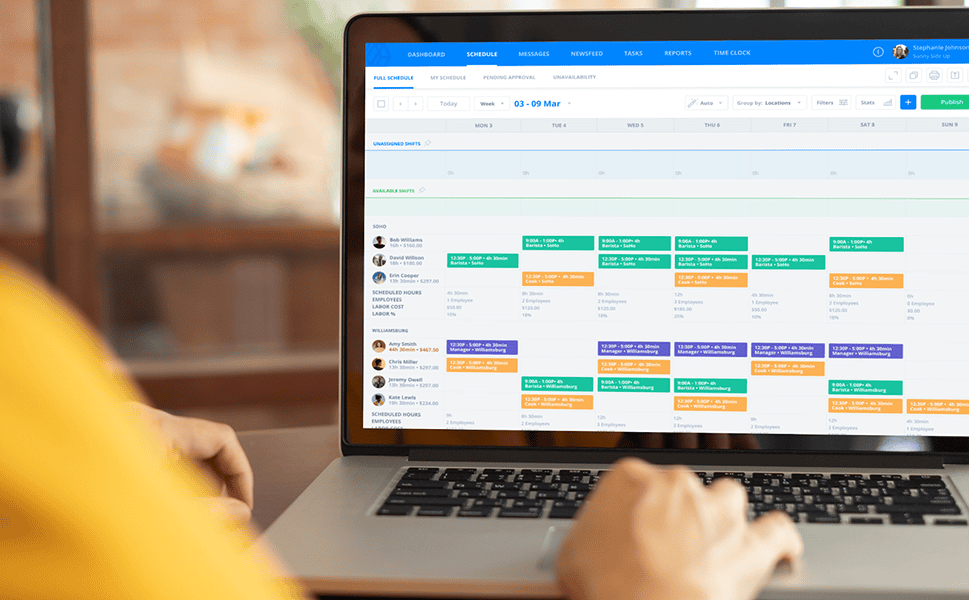Predictive Scheduling Laws: What Every Business Needs To Know
Cities and states across the country are slowly passing predictive scheduling la...
Employee time tracking is all about simplifying and streamlining the recording and reporting of hours worked so that the process doesn’t act as a speed bump to your team’s productivity.
In this article, we discuss tips that can transform your employee time tracking into a well-oiled machine so that everything further down the process chain is easier and more accurate.

Employee time tracking is the practice of recording and collating information about when each member of your team works and doesn’t work.
For businesses that pay their employees by the hour (be it part-time or full-time), time tracking is the foundation for calculating paychecks and the benefits they receive.
Team members clock in when they arrive at the workplace and clock out when they leave for the day. Some businesses also require that their employees clock in and out during breaks so that management can get a more accurate picture of actual time spent on the job.
For businesses that pay their employees a salary, employee time tracking is often used as a means to observe and control project costs.
Team members record the amount of time they work on a specific project throughout the day, and that data is then incorporated into calculating the true cost of the job (and estimating expenses for future jobs).
At its most basic, the theory of employee time tracking is fairly simple and straightforward. But, when your business takes into account the total number of employees, tax laws, payroll, and any number of other factors, it becomes a full-time job in itself.
That’s why it’s essential to do everything you can to make your tracking system as efficient and effective as possible.

The process of employee time tracking in a restaurant can be a bit more complex than the process in an office setting where everyone works the same shift each day, but the basic ideas are the same.
Regardless of the type of restaurant you run — or the size of the operation or the number of locations — one of the best things you can do to make things easier is to implement time tracking software into your team’s workflow.
And, with the right solution in place, you’ll be able to do much more than just monitor work hours.
Advanced tracking software like Sling allows you and your team to:
When considering which app to use in your business, keep in mind that the ideal solution is a single suite of tools with the flexibility to do everything mentioned above.
Avoid wasting time trying to assemble many separate apps that may or may not work well together.
Then, once you’ve got your time tracking software in place, try the tips in the next section to make the entire system run better from start to finish.

One of the most important factors to consider when implementing a time tracking system is how you’re going to educate your team. They’ll need to be trained to operate the equipment and have at least a basic understanding of how and why it all works.
Give them as much information as possible so that they can see how keeping track of their hours worked will benefit both them and the business.
Educating your team in this way will help make everything more productive and reduce confusion and errors later on.
Whether you’re introducing a new system into an existing workflow or training a new team member to use the existing system, an onboarding process is invaluable for ensuring that everything and everyone works smoothly.
A formalized training program or onboarding process also guarantees that all your team members receive the same level of information and have the same access as their coworkers.
Streamlining your time tracking system starts with documenting all the processes involved. The best place for this information is your employee handbook.
When all the procedures are collected in a place that your team can access at all times, it cuts down on — or all but eliminates — the need for managers and supervisors to take time out of their day to address problems.

Another essential step in ensuring your employee time tracking system stays effective and productive is complying with all local, state, and federal laws and regulations.
To make sure your business is in full compliance with local, state, and federal mandates (such as overtime, wages, or recordkeeping), consult an attorney who is familiar with labor law in your industry.
Most businesses find that automating their time tracking with workforce management software is the best way to maintain federal, state, local, and industry compliance.
Regardless of what your business does and where it’s located, employee management software is the best solution for streamlining the time tracking process.
Apps have built-in features that make it easy to:
For more information on the best way to automate your employee time tracking process, check out these articles from the Sling blog:
Time theft is when an employee accepts wages for work they didn’t do. The theft can be deliberate, accidental, or just negligent.
Regardless of how the theft occurred, the loss of both time and money can have a negative impact on the way your business operates.
Instead of accepting the loss of business resources due to time theft, prevent it from happening in the first place with these tips:
If time theft does occur, issue a verbal warning. If it occurs again, consider a written warning in their file, docking their pay, suspension, or even termination.
Whatever discipline you choose, make sure everyone is aware of the punishment beforehand, and do your best to follow through with each employee who breaks the rules.es.
However you choose to structure your business’s employee time tracking system, keep the process as simple as possible.
For the team members who use it daily, the entire clock-in/clock-out operation from start to finish should only take a few seconds.
Whether it’s punching a paper sheet, swiping an ID card, typing a PIN, or having their fingerprint scanned, anything more than 10 or 15 seconds is too long to be productive.

Keeping things as simple as possible also involves collecting just the right amount of information to be useful, but not too much that your data becomes cluttered and hard to analyze.
Hourly employees should clock in at the beginning of their shift and clock out at the end of their shift. For some businesses, that may be all the information they need.
Other variables you may need to track include:
In some cases, your businesses may even need to track time spent on specific projects or tasks.
Doing so adds another layer of complexity to the time tracking process, but if it’s what your business needs to run smoothly, then so be it.
For most businesses, tracking employee work hours is just the tip of the iceberg. A lot of other processes depend on those numbers, including performance standards, payroll, overtime, labor law compliance, and more.
You can save time and money by integrating time tracking with other tools in your business so that the data automatically flows from one system to another.
For example, the Sling suite of tools integrates seamlessly with Toast and allows you to compare Toast POS sales data to Sling labor costs and export employee timesheets directly to Toast Payroll (just to name a few).
Such integrations make it easier than ever to use data gathered in one part of your business and apply it to another part of the business without having to manually re-enter a long list of numbers and risk making mistakes along the way.
Your employees are on the frontline of the time-tracking process every day, so they know what things are working and what things aren’t. Asking for their feedback and implementing their suggestions when possible can go a long way toward making the system better.
An easy way to start is to set up a digital or paper-based “suggestion box” dedicated solely to the employee time tracking process.
Encourage your team to submit their thoughts about:
Then, schedule a meeting and go over the suggestions with your team to get even more feedback.
You may not be able to implement it all, but there may be one or two nuggets that everyone agrees would make the system better.

While using 24-hour time and rounding won’t affect the way your team clocks in and out, it will make things easier for you and your accounting team down the line.
If you manually calculate total hours worked each day, 24-hour time can streamline the process so much that you may be able to quickly do the math in your head.
Here’s why: 24-hour time doesn’t “restart” every twelve hours like the standard format. That means that the morning hours stay the same as you’re used to (1 through 12), but one in the afternoon becomes 1300, two in the afternoon becomes 1400, and so on.
So, if an employee clocks in at 0700 and clocks out at 1700, you can simply subtract the smaller number from the larger number (1700 – 0700 = 10 hours). You can’t do that with the standard format (which would be 5:00 p.m. – 7:00 a.m.).
Rounding laws allow businesses to round clock-in/clock-out times up or down to the nearest 10- or 15-minute mark.
Most businesses choose the 15-minute option (because it’s slightly easier), but there’s nothing wrong with the 10-minute option either.
In the 15-minute rounding option, employee work time from one to seven minutes is rounded down, while time from eight to 14 minutes is rounded up.
So, if Rick clocks in at 0758 (24-hour time) and clocks out at 1707, you would round the start time up to 0800 and the stop time down to 1700 for a total of nine hours (1700 – 0800 = 9.0) worked that day.
Once you’ve got your employee time tracking system dialed in, analyze the data to gain insight into the way your business operates and to make smarter decisions about how you use resources.
The reporting feature that comes standard in some of the more advanced workforce management apps (such as Sling) can help you:
Taking the time to analyze your employees’ work hour data can give you more control over the larger aspects of your business that affect your bottom line, including labor costs, payroll, savings, and cash flow.
Employee time tracking taken to the extreme can start to feel like micromanaging.
If you try to account for every last minute of an employee’s day, they may start to feel like you don’t trust them. That can affect their morale and productivity for the worse.
For hourly workers, encourage accurate start and stop times, but give a bit of leeway in-between for breaks, colleague interaction, and other social situations that contribute to employee happiness.
Before you send your employees’ timecards off to be processed for payroll, review the numbers to make sure they don’t deviate from your business’s standards for acceptable time tracking.
Reviewing the numbers on each timesheet can help:
If you have to contend with a lot of timecards, consider delegating the review to trusted managers so the task isn’t so overwhelming.
According to the Fair Labor Standards Act, businesses must keep employee time tracking data for a minimum of two years.
This applies to any records that affect wage computations, including:
Businesses must also keep any payroll records that result from the time tracking data — typically for more than two years.
Visit the Department of Labor’s website for more details.

The key to easy and accurate time tracking is choosing the right software for the job. Look no further than Sling.
The Sling app was built to streamline a large portion of your scheduling, time tracking, and attendance reporting work.
With Sling, you can build your employees’ schedules within minutes instead of hours and manage time off, availability, and shift-trade requests without collecting, sorting, and collating a huge stack of paper.
Add to that the onboard A.I. that will help you schedule overtime and avoid exceeding your labor budget, and you’ve got a powerful ally in keeping expenses under control.
Sling will even help you reduce absenteeism and late arrivals and keep track of overlapping shifts and double-booking.
Sling also offers a unique feature that turns any phone, tablet, or computer into a time clock. It allows your employees to clock in and out of their shifts without clogging up a central terminal. Sling even notifies you when an employee is running late or forgets to clock in.
And that’s just the beginning of what Sling has to offer to help you better manage your employees.
No matter the size of your business, Sling helps you organize your employees’ work schedules in less time so you can move on to other, more vital, tasks.
The benefits that make Sling a leader in the industry don’t stop with time and attendance tracking features. Sling also addresses the difficulty of labor costs. These expenses are one of the largest capital outlays any business has to absorb.
And since you can’t manage what you don’t measure, Sling’s labor cost feature helps you optimize your spending while you schedule. That means there’s less back and forth trying to reconcile your employees’ work schedules with your labor budget.
You can even use Sling to assign tasks to groups or specific employees, set due dates, and then follow their progress through to completion.
For more free resources to help you manage your business better, organize and schedule your team, and track and calculate labor costs, visit GetSling.com today.
This content is for informational purposes and is not intended as legal, tax, HR, or any other professional advice. Please contact an attorney or other professional for specific advice.
See Here For Last Updated Dates: Link
Schedule faster, communicate better, get things done.